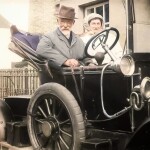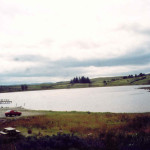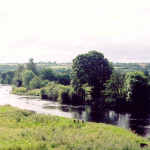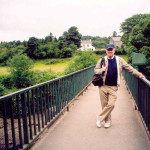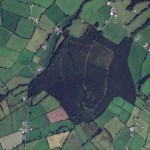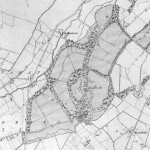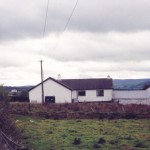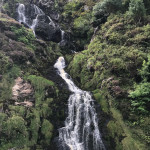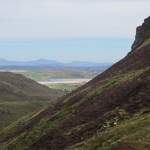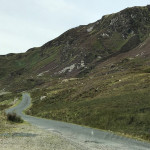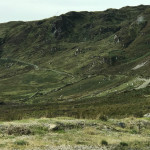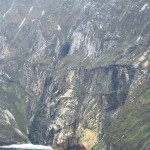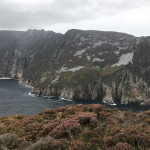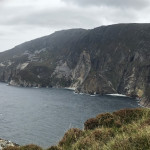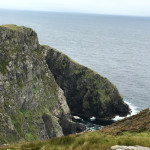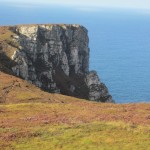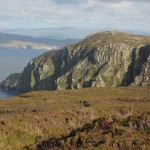During Ireland’s war with England in the 1900s, members of the IRA needed to get quickly from Glenfin to the Rosses in west Donegal, about 50 miles away. They had an idea to commandeer one of the only motor cars in the area to do so. It belonged to Dr. Johnston of Stranorlar. One fellow had the idea to telegraph Dr. Johnston that Mrs. Boyle of Glenfin needed immediate medical treatment. Mrs. Boyle lived near the Reelin Bridge, so the IRA threw up a barrier at the bridge to stop the doctor on his way to see Mrs. Boyle. When he arrived, the lads confiscated his car, and they proceeded to drive to the Rosses to meet up with the other troops. A song was written in honor of this actual event by Willie Gillespie (1883-1967) of Sessiaghoneill Townland (near Balleybofey) called “Johnston’s Motor Car.” The song became very popular and is sung today by Irish musicians in pubs and concert halls around the world. It was recorded by the Clancy Brothers, the Dubliners, and too many others to mention.
Daniel Kelly – Donegal Rebel
Daniel Kelly, a Killygordon native, was active in the Irish Republican Brotherhood (IRB) rebel movement in the early 1900s.
After working some years in the railways of Scotland where he attempted to establish a branch of Sinn Fein, he returned to Donegal in 1912 and worked at the Dungloe Road Railway Station and then the Cashelnagore Station near Gortahork. In 1913, he organised Irish Volunteer Companies in Cloghaneely and Creeslough and purchased arms and ammunition. The outbreak of the World War in 1914, split the volunteer companies in two. There was John Redmond’s National Volunteers who favoured supporting the war in Europe, and the Irish Volunteers who supported Irish independence. Kelly lost many of his Irish Volunteers due to British Army recruitment.
He and IRB member James McNulty organised a rally at Doe Castle near Creeslough in 1916. Patrick Pearse was scheduled to participate but planning for the Easter Rising prevented his attendance.
On Easter Sunday 1916, the IRB ordered the Irish Volunteers to mobilize for their rising in Dublin, but the Irish Volunteers were under the command of Eoin MacNeill. MacNeill saw no chance for success of the Easter Rising and cancelled all Volunteer activities. Daniel Kelly and some 33 volunteers nevertheless planned to participate but were hampered by the fact that they couldn’t get to Dublin in time because no trains were running.
On the Saturday after the rising on Easter Monday, the Royal Irish Constabulary arrived at Daniel’s home at the railway station to arrest him. They searched his home and found weapons and ammunition. Daniel was taken with other arrested volunteers to various prisons until he was incarcerated in Frongoch Prison in Wales.
Daniel Kelly was released from Frongoch Prison before Christmas 1916. He and his family moved to Ballybofey where he was chosen by the IRB to take part in its reorganisation in Donegal. During the Irish War of Independence, a few year later, Kelly was active in the areas of Ballybofey, North Donegal, and Derry.
Foe a detailed report of ALL Kelly’s rebel activities before and after the War of Independence…in his own words, see http://www.militaryarchives.ie/collections/online-collections/bureau-of-military-history-1913-1921/reels/bmh/BMH.WS1004.pdf
One of the more unusual incidents reported by Daniel in this report is when the IRB blocked a troop train in Donegal by rolling boulders across the tracks. The volunteers were supplied with hand grenades and were entrenched about 50 ft. above where the train stopped. They attacked with the grenades and a few rifles. A British officer reported: “If the blighters had opened the pins of the bombs, there would not have been one of us left alive”. He said that they just threw the hand grenades the same as they would throw a stone. When asked if anybody was injured, he said one of the men got a cut from broken glass. The train then backed up to the last railway station.
Some of this information is from “County Donegal in 1916 – From the Edge” by the Donegal County Council.
Trusk Lough
Trusk Lough is a body of water in Donaghmore Parish, County Donegal. In the past, water from the lough powered 15 mills on its way to the River Finn. These mills were owned and operated by the Johnston family who originally came to Donegal from France. The Johnstons raised the bank of the lough to retain more water and arranged for a single channel to carry the flow to the Finn. Initially there were objections by farmers when the other streams flowing out of the lough began drying up. These objections disappeared when the mills began generating a good deal of employment to people in the area. The Johnstons were known for treating their workers fairly.
A few years after the initial increase of the embankment of the lough, the embankment gave way, and many crops along the stream’s path were washed away in the flood. After this, the Johnstons obtained massive timber planks from a sunken ship in Lough Foyle and used them to strengthen the embankment and raise the water height to 12 feet. A sluice gate was installed as well so that the water could be released daily.
The Johnstons were landlords in the area and controlled the water rights to the lough until the end of the landlord system in the early 1900s. Operation of the mills then came under Henry McGowan. The nature of the mills changed from scutching flax and other tasks related to the linen industry, to a variety of industries such as corn mills, saw mills, threshing mills, and mills for churning milk.
Through the years, the number of mills decreased. Tony Gallinagh recalls four mills on the stream during his lifetime. They were owned by Paddy McGowan, Joseph Crawford, Henry McGowan, and John Foy.
The information in this article comes from Tony’s book “A Long Journey In A Short Time.” (browneprintersltd.com)
The Murder of Bella Brooks
In 1876, Bella Brooks, a servant girl in Donaghmore Parish (Cavan Upper Townland), was seduced by a farmer’s son and became pregnant. When the lad found out about the pregnancy, he gave her chloroform and with the help of his father’s servant, managed to throw Bella into the River Finn. Her lifeless body was found the next day floating on the river. The police responded and the doctor and coroner examined the body. The locals believed that the doctor and coroner were bribed to conceal critical details of her death. It is not clear who, but either the doctor or the coroner met his death a year later.
Donnchadh MacCongaile, master of Tievebrack National School (in Donaghmore) in the 1930s documented a poem by Francy the Fiddler (Francis Kelly) about the murder. It was included in the Irish Folklore Commission’s project to preserve old stories of the past. The poem is shown below. A longer version can be found in Tony Gallinagh’s book, “A Long Journey in a Short Time.” (Browneprinters Ltd., Letterkenny)
The Murder of Bella Brooks
You tender-hearted Christians, I hope you will draw near,
I claim your kind attention, and I won’t detain you long.
It’s all about a foul murder that took place some years ago.
And how the crime was perpetrated I mean to let you know.
It was about three miles from Castlefin in the County Donegal,
There lived a farmer’s daughter, handsome, young and tall.
She had received some visits from another farmer’s son,
But he was sly and cunning too and soon her favour won.
He took her to his father’s home, a while there for to keep,
One night he gave her chloroform which caused her for to sleep.
And when he got her sleeping, he went to his servant man.
They hurried off to execute their wild and wicked plan.
But to continue some wicked deed, this fair maid to destroy
To steal her out alone at night between him and his servant boy.
They dragged her to the water’s edge and cruelly threw her in.
Next morning her lifeless body was discovered in the Finn
And the people were all shocked to hear that Bella Brooks was drowned.
The doctor, – he was sent for, to drag her to the shore
But human aid was useless her life to restore.
The police, – they were sent for and the news soon spread around
The coroner met to cruel end, and the people do me tell,
One night he got his neck broke, when off his gig to fell
If her parents had been living she would have got fair play
They would have had this man arrested, by whom she was beguiled
And have him tried and punished
For the murder of their child.
Footbridge to Drumboe
The first footbridge over the Finn from Ballybofey to Drumboe was erected in 1942 by the McMenamin brothers, James and Paddy. The brothers owned land on both side of the river. Prior to the bridge, the brothers used a row-boat to cross the river. The first bridge was built of shoddy material (because of the war) and collapsed within a year after it was built. Paddy McMenamin with his friend Joe Blee attempted to repair it, but both fell into the river while trying to fix it. The bridge was finally placed back in service in 1944 but was mainly used by the McMenamins on their daily milking runs. Public use of the bridge was discouraged. A locked gate was placed on the Ballybofey side. Chain link sides to the bridge were added around 1946. Later, the McMenamins gave in to requests by locals to use the bridge. In 1970, James’s son Charlie donated the strip of land linking the bridge to Drumboe Woods.
The bridge was closed after being damaged by a huge flood in 1984. It returned to service after the Donegal County Council agreed to repair and strengthen the bridge. It is now a convenient way to access Drumboe Woods from Glenfin Road on the Ballybofey side of the Finn.
Information about the Drumboe footbridge was obtained from the book, “A Long Journey In A Short Time” by Tony Gallinagh (Browneprinters Ltd , Letterkenny)
Monellan Castle and Estate
Monellan Castle was an impressive building located just south of Crossroads in Donaghmore (Killygordon) Parish, County Donegal. The castle, which was the manor house of the Delap family, was a 35 room dwelling with part of it underground to be used as a place of safety if required. The castle and its grounds were in full glory from the late 1700s until its demolition in the 1930s – on orders given to the Irish Land Commission from the new Irish government. It was the largest building in the Finn Valley at the time, set in beautiful surroundings second to none in the area.
It is believed that the Monellan estate was granted to a Colonel in the British army for “services rendered to the Crowne.” The Delaps became owners in the late 1700s.
Monellan Castle was built by expert stonemasons from the localities of Meenreagh, Lismullaghduff and Killygordon, with Scottish supervisors looking after the work and took almost three years to complete. It also had a large number of outhouses for the use of the land stewards, servants, maids and coachmen. These buildings extended from a spot known locally as McGlynn’s Bridge, and included Monellan Burn Pass, Edenoughill and Casey’s Brae, and included byres, stables and other buildings for domestic uses. Surrounding the main house were beautiful flower gardens, tennis courts and a bowling green. The approach to the castle must have been beautiful to behold, done out with rhododendron hedges, especially when the hedges were in bloom.
The house, gardens, private grounds, arable land and small parts of the forest were protected by a high wall, extending three miles around most of the estate. Most of this wall remains today and is the only lasting sign of this once fine estate. No wall was required for the part of the estate adjoining the townland of Ballinaman, as a large tributary of the River Finn, known locally as Monellan Burn, served as protection.
The Delaps gave employment to many local men and women. For the then wage of sixpence per week, each worker could take home with them on Saturday night, some milk, potatoes, vegetables and even flowers if a special celebration was in order. Up to twenty women would be employed at the castle each Monday, wash-day, to wash the bedclothes, linen, and tablecloths. All had to be steeped in tubs on the previous Saturday for washing on Monday. On completion of the washing, all the garments had to be put through a hand-operated roller-wringer and dried outdoors. Those walking on the Monellan-Glen road would see the long line of clothes laid out on the neatly trimmed rhododendron bushes.
The Irish Land Commission ordered the destruction of Monellan Castle in the 1930s. The Land Commission was created in 1881 as a rent fixing commission by the Irish Land Act 1881 for Ireland. Later the commission developed into a tenant-purchasing commission and assisted in the transfer of land from landlord to tenant. It’s easy to say now that the destruction of the estate was a mistake but many local people benefited at the time. Some of the small farmers who had bad housing conditions were particularly lucky as the Land Commission built them new and better houses. Most of the stones from the castle were used to build roads on Cronlaughey and Meenlaught in early 1945. Most of the bogland divided at the time has been cut out and is no longer workable.
The aerial photo shows just how much and how little the area has changed since the original buildings were demolished. It’s probable that the presence of the estate wall has helped preserve the outline of what is now forestry.
The Delap Family
The Delaps came into possession of Monellan after Robert Delap of Ramelton married Mary Anne Bogle, the only child of James Bogle who owned the estate. They married in 1776. Robert inherited the estate following James Bogle’s death. Robert and Mary Anne had three children, Samuel Francis Delap (b. 1777), James Bogle Delap (b.1779), and William Drummond Delap.
Following Robert’s death in 1782, Samuel obtained ownership of Monellan and started the building of the “Big House.” James moved to Surrey, England and became a Colonel in the King’s 1st Regiment of Dragoon Guards. William moved to Monsterboyce in Co. Louth.
Sam Delap married Susan Bennett in 1800 and had sons Robert (b. 1802) and John and two daughters. Both sons eventually became clergymen. Sam’s son Robert was the last of the Delaps to own the estate prior to the Land Commission taking ownership. Robert was a trained barrister and a student with Daniel O’ Connell. Soon after qualifying he changed from the practice of law to become a clergyman. Having completed his studies, he returned to Monellan Estate as Rev. Delap and became first Minister of St Anne’s Church of Ireland, which he was responsible for building.
Rev. Robert Delap married Isabella Galbraith in 1834. Isabella died in 1870.
Rev. Delap is buried in the grounds of St. Anne’s Church and his father Sam is buried in one of the aisles. He was buried standing up with a stone slab over the coffin. The slab had to be repaired several times due to subsidence as the coffin rotted away. Rev. Delap’s daughters lived at the estate for over 20 years after his death but eventually left when the estate was sold. They were buried as requested “in the grounds” with their dogs buried beside them. There are a number of graves close in the grounds of Monellan but only one of them is marked as a friend of one of the daughters, but it is pretty certain that this is the final resting place of Rev. Delap’s daughters.
Getting To Monellan
From the N15 Ballybofey to Lifford road, turn off at Killygordon for Crossroads. At the crossroads go straight on for Castlederg. Just past Donegal Creameries take the left turn over the old stone bridge. After approx. 400m, turn right up a tarred road. This looks like a private lane but leads past some houses to the forest gate and the old entrance to the former estate.
The land is now owned and maintained by Coillte who operate an Open Forest Policy. This policy prohibits the use of vehicles and bicycles on forestry land. However, the gate is usually open to allow access to the grave site and parking is limited outside the gate.
Thanks to Chris Irwin of Crossroads for collecting the information about the Delap family which I used in preparing this document.
Supple Matthew Gallen
During the Penal Times in Ireland (17th and 18th century), Catholic priests were banned from the country. Still, priests managed to sneak into parishes to celebrate Mass at secret locations such as at Mass rocks. It was the job of certain parishioners to act as “scouts” to ensure that the priests entered and exited the parishes safely without being captured by soldiers or priest hunters. One such scout was the legendary “Supple” Matthew Gallen of Donaghmore Parish (Killygordon) in County Donegal. This brief story of Matthew Gallen was written in 1934 by Reverend Walter Hegarty C.C. of the parish in his weekly column on the history of Donaghmore in the Derry Journal. It goes as follows:
SUPPLE MATTHEW GALLEN
Rev. Walter Hegarty, C.C.
Derry Journal – April 6, 1934
…This leads us to the story of Supple Matthew Gallen, which I got from Jas. MacLaughlin of Tievbreac, who got it from John Mongan of Ballymongan. This John was the last great storyteller of that district. He was a basketmaker by trade, and, like the old tradesmen, liked to stay a week or two at every house he visited, and the neighbours gathered in to hear his tales.
When the Gallens were driven out of their ancient homeland across the Finn, they came to live in Meenreagh on the Mourne water, and there Matthew was born. His people were active, but he surpassed them all, so that in early manhood he won the title of Supple Matthew. In those days, brave men were needed to guard the priest, Matthew set him himself as the priest’s runner. He would hang about the headquarters of the priest-hunters and find out if they were possessed of the information where Mass was to be said. If they headed out in the proper direction, by taking nearcuts he could outpace their horses and give warning to the Mass hearers. If the pursuers were rather close at hand, he would assume the part of a priest, probably by a borrowed cloak, let himself be seen, move off slowly at first so that his enemies might take up the trail and then with windings and turnings ever faster and faster, he outwitted them all. One such run was told to me by Patrick Crampsie, a feat probably of Matthew’s, which began at the Carran, went up and across the hill, then down again and over the Finn.
There came a close Sunday morning. Mass was to be very far away, near a holy well, but word had reached the persecutors and they made out. Matthew knew how little chance he had of being there in time, but with superhuman effort, he accomplished the feat, shouting a warning and threw himself down on a stone ditch. The laity scattered and as the priest turned to go, he saw Matthew lying. He went over to warn him that, as a marked man, he had better be moving, touched him on the shoulder and found he was dead.
“Minshe Finn” in the Ballintra area is the place it is said that his earthly life ended. If anyone can give any information about this hero of Meenreagh, I should like details. I wished to get the story written up by one of our well-known writers, but it was held up by expecting further news. Meanwhile, Jas. MacLaughlin has been seeking a fresh source, an informant whose profession takes him round a little after the style of John Mongan.
Assaranca Waterfall
Glengesh Pass
The Slieve League Cliffs of Donegal
Located on the western coast of County Donegal, the Slieve League (Sliabh Liag) cliffs are the highest sea cliffs in Europe, a 1998 feet (609 m.) drop to the Atlantic Ocean. They are almost 3 times the drop of the famous Cliffs of Moher in County Clare.
The sights at the various viewing points are spectacular, and hiking and guided walks are available. The adventurous can take a walk to the highest point of the cliffs on a path called One Man’s Pass. A more gentle route is also available. This highlight of Donegal is not to be missed.

